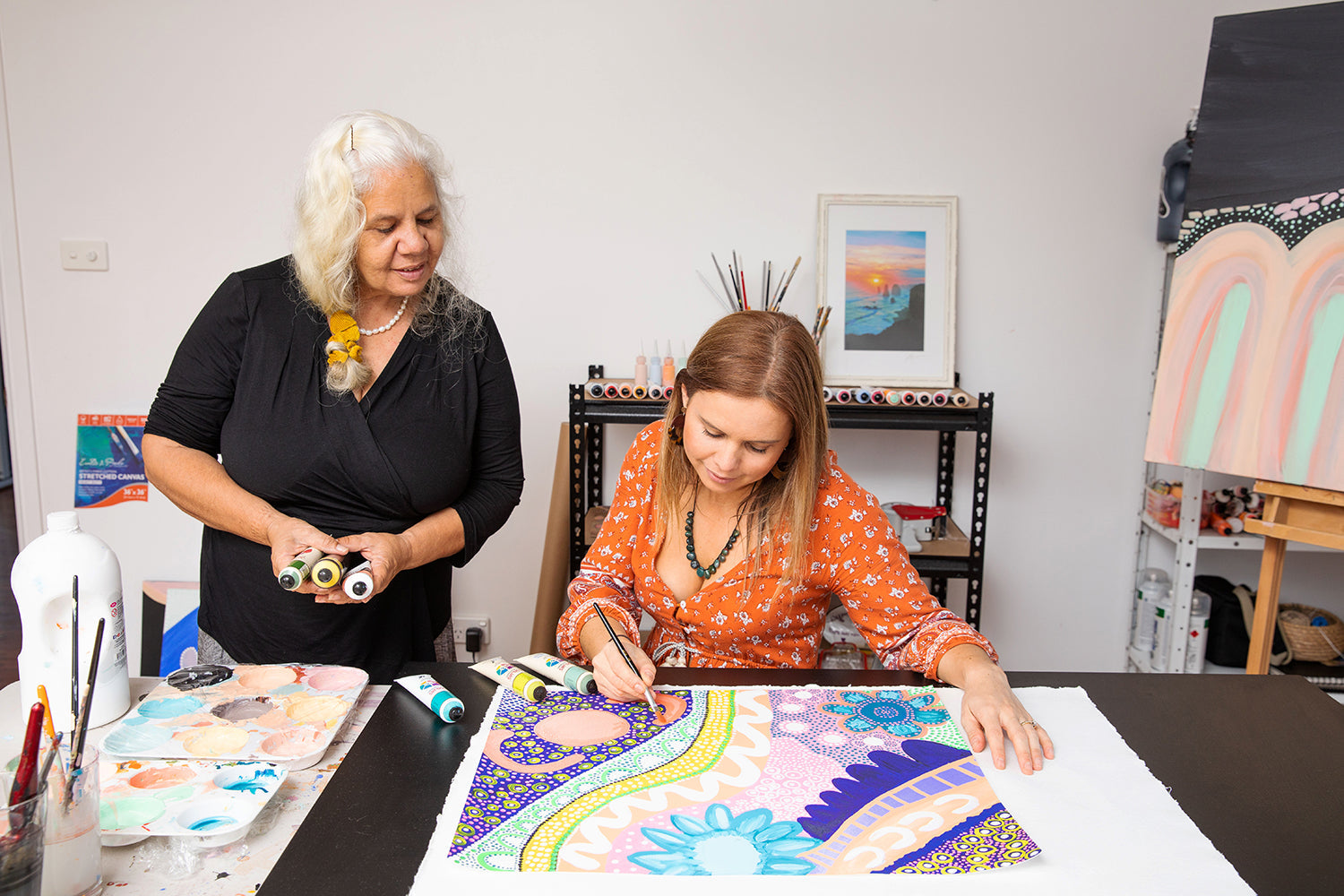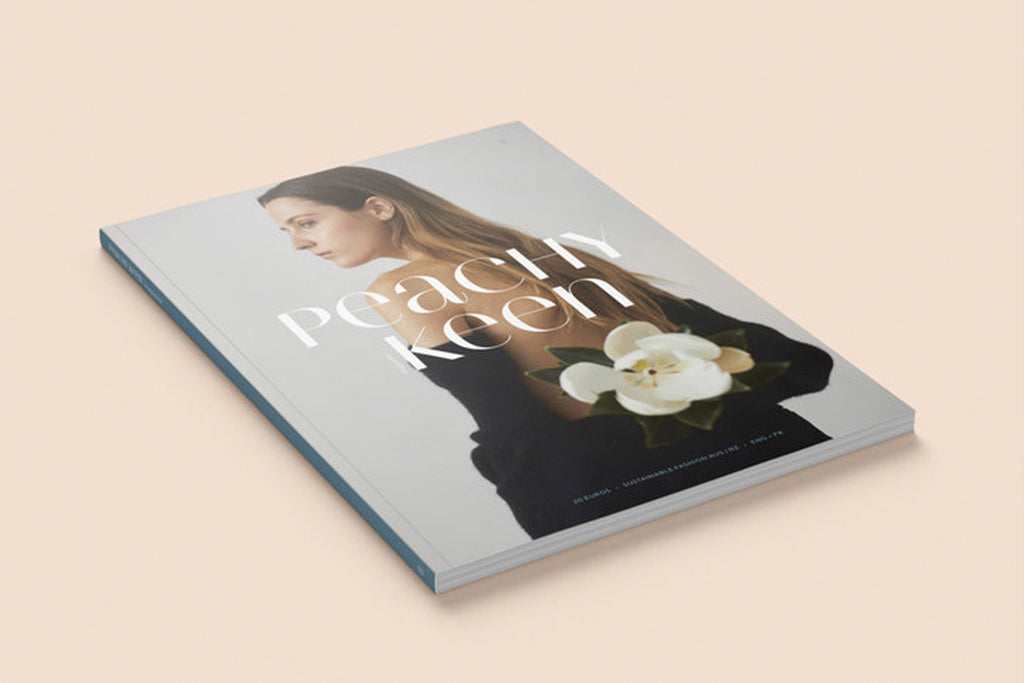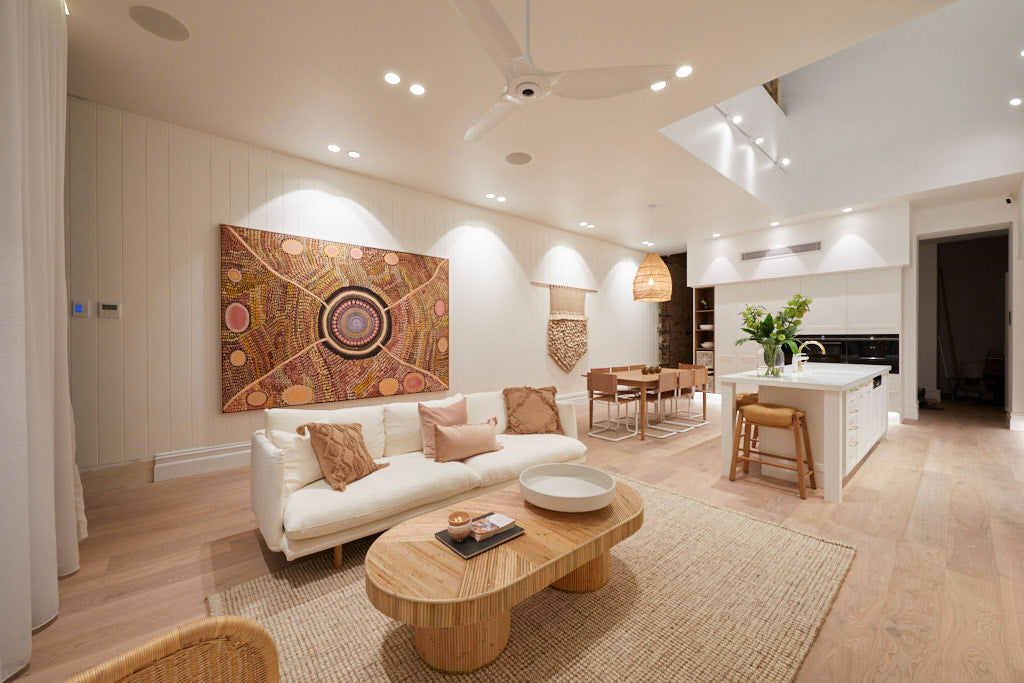
ART THY NEIGHBOUR - Featured Article
Aboriginal trauma and strength: Lauren Jarrett and Melissa Greenwood’s traditional paintings capture the energy of the land
In an orphanage in Grafton, NSW, Lauren Jarrett felt like an outsider. At nine years old, she had never seen nuns before and, in those days back in 1966, nuns wore long robes with cartoonishly large crucifixes. It was a world away from her home in Gumbaynggirr country.
Lauren was stolen from her home by men who wrongly believed she would be better off growing up in white culture, and she was made a ward of the state at a time when Aboriginals weren’t considered citizens of Australia. When they took her, seven of her older siblings had already been stolen. Years later, she learned her mother had a nervous breakdown.
The nuns were intent on stripping Lauren of her Bundjalung-Gumbayngirr-Dunghutti cultural identity.
“When I was growing up in the orphanage, they denied me of speaking my traditional language or being anything Indigenous, I was determined to keep my culture and spirit alive,” Lauren told me.
“The Sisters of Mercy forbid anything cultural. We were not to speak our language, tell dreaming stories or dance corroboree anymore. My dreaming died then, but it was not to be forgotten.”
In a cafe by the ocean in Seaford, I chatted with Lauren and her daughter Melissa Greenwood.
Melissa and Lauren recently opened their own business called Miimi & Jiinda (meaning mother and sister), selling vibrant Indigenous art rooted in womanhood, culture, resilience and strength. And they’ve been gaining fans by the thousands on Instagram.
“Mum came to live with me for two and a half years in Melbourne to help raise my son, and during that time she passed on her knowledge and skills. We really got into painting and weaving together,” Melissa says.
“I was like, ‘Mum, we need to start a business. Your house is filled with baskets from over 30 years - we need to get this out into the world’. We started with a small market stall and it has just taken off ever since.”
Deep and soft pink is often used in their paintings, and Melissa tells me that pink hues represents their matriarchal ties and strengthen ties to their dreaming.
One painting, for instance, titled The Original Birthing Caves, portrays caves where women gave birth, surrounded by midwives. Birthing caves were chosen for their sacredness – spaces that were sheltered, near fresh water and surrounded by plants for medicine and food.
In an Instagram post, Melissa wrote: “The women are revered. They are the ones who carry life. They are the creator. Mainly it is the mother who nurtures - she provides the patience, nourishment for life and life itself.”
After a woman gives birth, the father plants the placenta in the ground, beside the cave. Opposite the birthing cave and the buried placenta, a third point is created where the person is buried when they die. It creates a full circle.
“I had strong women around me before I was taken away,” Lauren says. “They were very loving, very knowledgeable, and had a great sense of humour. They still knew a lot of traditional things even though they weren’t allowed to live traditionally. We were shown things on the quiet, and we ate a lot of traditional foods. We did as much as we could.”
Melissa adds: “That instilled in her the cultural knowledge - she was lucky she had that time with her family. In the orphanage, no one cared. It was horrendous.”
Keeping her culture alive was what Lauren says helped her heal from the childhood trauma that members of the Stolen Generation still suffer from.
Lauren left the orphanage after nine years and became a nurse at St Vincent's Hospital in Lismore. But to heal, she needed to reconnect with her Aboriginal identity. So she set about learning traditional dancing and basket weaving.
In fact, Lauren has been a master weaver for decades, and her baskets have been displayed in some of Australia’s top museums and galleries, including the ‘3 Barks Bag’ which was purchased by the National Gallery of Australia.
Lauren: “You’re so busy in your head all the time, and weaving gives you a break from that. It puts you in a meditative space. Women who weave will sit around and chat about women’s business and gossip.”
Melissa: “You have to go out and source the plants, bark from the trees, there’s a whole process. We forage, speak to the plants and ask permission to the ancestors when you’re on the land. You feel very connected.”
I’ve always wondered what it actually means to feel connected to the land. I ask, knowing it might be difficult for anyone to express such an ancient spiritual emotion.
But Lauren’s perfect analogy takes me by surprise, and I often think back to this when I escape the city.
“We walk barefoot on the land, and envision ourselves going right into the earth like the roots of a tree, but also reaching up into the universe, because your soul is that big. You feel a one-ness,” she says.
And Melissa adds: “Another word could be anchored. It’s a sense of clarity.”
It’s easy to see this rich one-ness reflected in their paintings. Their art is personal and tells their interpretation of dreaming and creation stories.
“But we don’t always do that. Sometimes we paint intuitively, where we tune in and ask for guidance from our ancestors, and then it just flows,” Melissa says.
At the moment the pair use acrylic paint, but say that in the future they’d like to source natural ochre and dyes, and make the process fully natural.
Their paintings are energetic, vibrant and can brighten a room. And when they’re not working together in person, they’re collaborating over the phone or on the computer to bring their culture alive on canvas.
Lauren says she passed her creativity down to her children through encouragement and as a way to heal from intergenerational trauma. Her post-traumatic stress disorder that Lauren and Melissa speak of candidly runs through Melissa and her siblings’ DNA. And scaling out, the trauma runs through the veins of tribes and communities whose relatives were among the Stolen Generation.
“There’s still a lot of trauma affecting the youth. When we’re ready and set up properly, we’ll probably do women’s circles to help young people,” Lauren says.
Melissa: “We’d like to eventually run weekend retreats, take women out bush, share dancing and weaving.”
To more widely share their work and open their business, the two have begun putting their art onto products, even painting the boots of a few Brisbane Broncos rugby players: Jack Bird, James Roberts, David Fififa, and Kotoni Stags, for an Indigenous Round.
In fact, Lauren says she wants to paint more players’ boots, perhaps for Indigenous Rounds in the AFL.
“We hadn’t done something like that before, and it was quite tricky, but we really enjoyed it,” Lauren says.
I ask Lauren just what she thinks is the biggest thing she has taught Melissa, and ask Melissa what she’s learned from her mum.
Lauren: “I think respect is the biggest thing. Respect for yourself, respect for others and the world you live in. I’ve shown her techniques and she has appreciation for the spirit of the land and what you want to bring out and put on canvas. She’s got that from me.”
Melissa: “I’ve learnt patience from my mum. Inner knowing and connecting to self and the ancestral knowledge that comes through.”
Lauren and Melissa are undeniably close, and their constant banter kept my fingers flying along the keyboard when we caught up. Lauren explains that she has different totems for different times in her life and for different relationships. When her children were born, her totem was the bush turkey.
“It creates the nest, and fuss, fuss, fuss. And then it takes a step back. I had that same mentality with my family,” she says.
“I’ve had experience with owl dreaming, dingo dreaming and I’ve tuned into wallabies - it’s constant. You can’t really say one because we’re related to nature and plants and birds and fish. It’s one-on-one communication with their spirit. I’m probably a bird woman, there’s always a bird around to communicate with.
“The land is living and we just take that energy and put it into our paintings, It’s reciprocal and interconnected.”
Melissa: “Nice one, Mum!”


